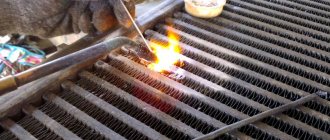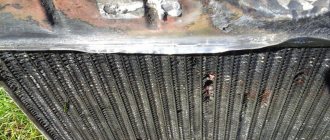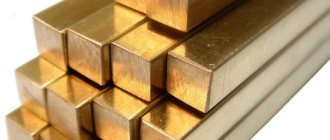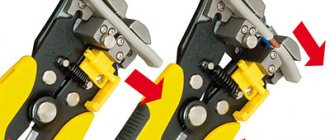When a car's heating system fails, a common cause of problems is a faulty heater core. Therefore, there is an urgent need to replace this element on your car. The procedure for changing the stove element itself may differ depending on the design features of the car. But the key issue here is the right choice. The main dispute is over aluminum and copper products. It is not always possible to give a definite answer to which radiator is better - aluminum or copper. To do this, you need to study their features, strengths and weaknesses. This will allow you to give an objective assessment of the devices and understand whether there is an obvious leader among them.
Recommendations for choosing a radiator.
Which has better heat dissipation: aluminum or copper?
I was somehow also puzzled by the aluminum-copper problem for the radiator.
I bought aluminum. The idea was this: copper conducts heat better, but a lot depends on the shape. A copper radiator is thinner and has much fewer fins than an aluminum one. IMHO, aluminum will have a larger cooled surface area. . Incorrect installation. The fact is that due to the better heat dissipation properties of copper, the smaller area of the copper radiator is identical in heat transfer to the larger surface of the aluminum
My copper one is 2 centimeters thick, as opposed to probably 6-8 cm of aluminum, but it works better.
In addition, do not forget that if the copper one is made at a factory, and not in the basement, then its plates are soldered. to the tubes and not crimped like on aluminum, and this greatly improves heat transfer.
The installation is no more incorrect than comparing a 16-year-old clogged aluminum radiator with a new copper one by eye. No wonder it works better.
IMHO, the incorrect setting is contained in the phrase: “The fact is that due to the better heat-removing properties of copper, the smaller area of the copper radiator is identical in heat transfer to the larger surface of the aluminum one.” There are concepts: heat capacity, thermal conductivity and heat transfer. For example, for a computer radiator, both thermal conductivity and heat transfer are equally important - heat must first be effectively removed from a point source (crystal), and then effectively dissipated. In a car radiator, the thermal conductivity of the material plays a lesser role (the tubes are thin, the losses due to thermal conductivity are small, the liquid is inside the tubes), but heat transfer plays a huge role, which depends not so much on the material and its thermal conductivity, but on the shape of the radiator and the area of its cooled surface.
It would also be nice, when quoting is used, not to cut off important sentences, somewhat distorting the meaning. (I repeat once again: “These are obviously speculative conclusions. Of course, it would be nice to measure heat transfer in laboratory conditions, but who would do it.”). This is so, by the way, it had to be.
Source
Radiator design
It is important to consider that the car has two radiators at once. One of them is included in the heating system and is in many ways similar to its older brother installed in the cooling system. Their functions are also similar. Only the cooling radiator mainly transfers the selected heat to the atmosphere, and the small one (heating radiator) is intended for the interior. Both devices provide for the presence of 2 tanks connected by tubes to each other. The plates necessary to increase the cooled area are mounted to them. The more plates the device has, the higher its heat transfer rate will be.
Therefore, when choosing a new heating radiator, you should definitely pay attention to the number of plates present. If their density is high, then the heat transfer will be at a high level. The main difference between them is the material of manufacture. The choice in favor of a copper or aluminum option is not so clear-cut. You should study in detail the characteristics and features of the two options in order to understand which one would be better to choose in each specific case.
A little about thermal conductivity
In physics, thermal conductivity is understood as the movement of energy in an object from more heated small particles to less heated ones. Thanks to this process, the temperature of the object in question as a whole is equalized. The magnitude of the ability to conduct heat is characterized by the thermal conductivity coefficient. This parameter is equal to the amount of heat that a material 1 meter thick passes through a surface area of 1 m2 for one second at a unit temperature difference.
| Material | Thermal conductivity coefficient, W/(m*K) |
| Silver | 428 |
| Copper | 394 |
| Aluminum | 220 |
| Iron | 74 |
| Steel | 45 |
| Lead | 35 |
| Brick | 0,77 |
Copper has a thermal conductivity coefficient of 394 W/(m*K) at temperatures from 20 to 100 °C. Only silver can compete with it. And for steel and iron this figure is 9 and 6 times lower, respectively (see table). It is worth noting that the thermal conductivity of products made from copper largely depends on impurities (however, this also applies to other metals). For example, the rate of heat conduction decreases if substances such as:
Copper wire
If you add zinc to copper, you get brass, which has a much lower thermal conductivity coefficient. At the same time, adding other substances to copper can significantly reduce the cost of finished products and give them characteristics such as strength and wear resistance. For example, brass is characterized by higher technological, mechanical and anti-friction properties.
Since high thermal conductivity is characterized by rapid distribution of heating energy throughout the entire object, copper is widely used in heat exchange systems. At the moment, radiators and tubes for refrigerators, vacuum units and cars are made from it for rapid heat removal. Copper elements are also used in heating installations, but for heating.
Copper heating radiator
In order to maintain the thermal conductivity of the metal at a high level (and therefore make the operation of copper devices as efficient as possible), forced airflow by fans is used in all heat exchange systems. This decision is due to the fact that as the temperature of the environment increases, the thermal conductivity of any material decreases significantly, because heat transfer slows down.
How it works
First you need to understand how the heater cores in your car function. The heat inside the cabin comes from the running engine. This is a kind of side effect of the operation of the power unit. It generates heat, which engineers have learned to use for the benefit of humans, that is, to heat the interior of the car with it. The heat itself is created as a result of the combustion of the air-fuel mixture and friction between the surfaces of engine elements. To remove this heat from the heated components of the motor, its design includes a cooling system. One of its functions is to heat the car interior.
A logical conclusion follows from this. The hotter the engine is, the warmer it can be inside the cabin. The coolant becomes hot, removing heat from the engine, and passes into the heater core. Here the fan comes into operation, blowing air through the heated radiator and distributing it throughout the car. To be more precise, around the cabin. The driver and passengers can regulate the temperature of the supplied hot air using deflectors and a tap, which are located on the line between the power unit of the car and the stove itself. This is the simplest shut-off type valve, which has a mechanical or electrical drive type. With its help, the amount of cooling liquid passing through the heating system is regulated.
If you raise the temperature on the control unit, the tap will open more. When the temperature decreases, the opposite effect occurs. Its functionality directly affects the operation of the machine's stove. If the system cannot provide full passage for the coolant heated by the engine, then the driver and passengers will feel cold. The temperature outside plays a big role. In the case of a serviceable and well-functioning heater, even it will not be able to warm up the interior as much as possible if the outside temperature is at a very low level. The colder it is outside, the more difficult it is for the stove to warm up the interior.
Aluminum and copper - which is better?
Aluminum has one disadvantage compared to copper: its thermal conductivity is 1.5 times less, namely 201–235 W/(m*K). However, compared to other metals, these are quite high values. Aluminum, like copper, has high anti-corrosion properties. In addition, it has advantages such as:
- low density (specific gravity 3 times less than that of copper);
- low cost (3.5 times less than copper).
Aluminum heating radiator
Thanks to simple calculations, it turns out that an aluminum part can be almost 10 times cheaper than a copper part, because it weighs much less and is made of cheaper material. This fact, along with high thermal conductivity, allows the use of aluminum as a material for cookware and food foil for ovens. The main disadvantage of aluminum is that it is softer, so it can only be used in alloys (for example, duralumin).
For effective heat transfer, the rate of heat transfer to the environment plays an important role, and this is actively facilitated by the cooling of radiators. As a result, the lower thermal conductivity of aluminum (relative to copper) is leveled out, and the weight and cost of the equipment are reduced. These important advantages allow aluminum to gradually replace copper from use in air conditioning systems.
Use of copper in electronics
In some industries, for example, in the radio industry and electronics, copper is essential. The fact is that this metal is very ductile in nature: it can be drawn into extremely thin wires (0.005 mm), and also can be used to create other specific conductive elements for electronic devices. And high thermal conductivity allows copper to extremely effectively remove the heat that inevitably arises during the operation of electrical appliances, which is very important for modern high-precision, but at the same time compact equipment.
The use of copper is relevant in cases where it is necessary to deposit a certain shape on a steel part. In this case, a copper template is used, which is not connected to the element being welded. Using aluminum for these purposes is impossible, as it will melt or burn through. It is also worth mentioning that copper can act as a cathode when welding with a carbon arc.
Where to choose
The question of choice still remains open. But you need to try to answer it as objectively as possible. Despite the shortcomings mentioned, when choosing a radiator several years ago, everyone would definitely have opted for a copper product. Such designs were objectively better and could ensure excellent performance of the entire heating system of the car. But now the situation is different. There are many manufacturers, but there are no truly high-quality copper elements as they used to be. This is due to the desire to reduce the cost of production.
As a result, all sorts of impurities began to be added to copper, which negatively affect strength, quality, thermal conductivity and other aspects that have always been considered the main advantages. Therefore, it is more logical to choose aluminum. This material does not need to be reduced in price due to impurities, therefore it actually completely retains its advantages. And car owners say the disadvantages are not so significant, since the radiator is still a consumable item that can be changed every few years.
Under current conditions, aluminum is objectively better than copper. But if you manage to find the highest quality product without any admixtures of other metals, then you can safely opt for a copper stove radiator. But what you should categorically refuse is painted heating radiators. The presence of a layer of paint significantly reduces heat transfer. In addition, when the paint coating heats up, it begins to emit an unpleasant odor that enters the interior of the car. Try to carefully monitor the heating system to prevent clogging of the channels. If they turn out to be clogged, the fact of what material these elements of the car heating system are made of will no longer play any role.
Manufacturers
If you have been able to determine for yourself which radiator is better, then all that remains is to resolve the issue with the manufacturer. Copper and aluminum are actively used in the production of their products by various companies that create components for automotive heating systems. There are a lot of good manufacturers, but everyone has their own experience in working with certain factories. It is impossible to objectively determine the best company. Some people speak well of them, others were not particularly pleased. The question is quite subjective.
But if you take into account the number of reviews, the level of sales and the opinion of experts, then the list of the most preferred manufacturers of copper and aluminum radiators for car heating systems should include:
- Fenox;
- Bautler;
- luzar;
- Radiator Iran;
- Oberkraft;
- DZA.
Don't try to save a lot on such devices for your car. Let you choose the aluminum option, which initially costs less than its competitor, but if the price is too low, do not expect high efficiency or other positive characteristics. Radiators are not designed to last for the entire period of operation of the vehicle. Therefore, this element will definitely need to be changed at some point. Most experts agree that for imported and domestic cars, despite its shortcomings, the best solution is an aluminum device. Such units are able to serve their life without creating unnecessary problems in the operation of the heating system.
Remember that dirt is generated equally in both design options. And this happens inside and outside.
It is not that difficult to clean the outside of the device. This will require a minimum of time and equipment. But with the internal part things are much more complicated. It is difficult to carry out high-quality cleaning; not everyone can cope with it on their own. Provided that the cooling system on your car’s engine is clean, you have a new car or have recently undergone a major overhaul, the copper heater radiator will be able to perfectly show its best qualities. Of course, if your car is designed to use such elements.
If you don’t know what condition your heating and cooling system is in, you don’t need to create additional problems for yourself and spend extra money. Install a good aluminum radiator and replace it with the same one after a few years of operation. As practice shows, such a way out of the situation is the most effective and correct.
Which conducts heat better: aluminum or copper?
Today, radiators are made from a variety of materials, the most common being steel, stainless steel and aluminum.
Always have doubts about which radiator to choose for installation in your home? Obviously, this depends on personal taste, as well as on the requirements that you have set for yourself regarding the quality of the heating of the room.
Aluminum is by far the most environmentally friendly material and has a huge number of advantages.
How to choose a heating radiator: expert advice
In this article we will not consider cast iron radiators, because... they are losing popularity among buyers.
Let's focus on the most popular models.
The material will tell you in detail about the advantages of aluminum and steel batteries.
Aluminum radiators are lightweight
Aluminum radiators are lighter than traditional steel or cast iron radiators, this fact makes it possible to place such a radiator on any wall in the room.
Aluminum batteries can be hung on the wall, even in situations where the thickness does not allow for deep fastening.
This significantly saves the cost of paying for construction work, since they can be hung very quickly and reliably.
We recommend that you familiarize yourself with the range of heating radiators presented in online stores; on the manufacturers' websites you can buy aluminum radiators from leading European manufacturers (ESPERADO, FERROLI, GLOBAL, FARAL, FONDITAL) with a 10-year guarantee!
Aluminum is a corrosion resistant material
Aluminum is not subject to corrosion, which makes it an ideal material for the production of radiators that are intended to be installed in areas such as bathrooms and kitchens where there is high humidity.
Aluminum conducts heat well
Aluminum heats up quickly, making it an excellent heat conductor.
Aluminum radiators have a low water content, which means that once turned on, such devices give an intense burst of heat and heat up rooms quite quickly.
By installing aluminum radiators, you can quickly achieve the required temperature in the rooms, as they have the shortest response time.
The main advantage is a significant saving in energy costs during the heating season and, as a wonderful bonus, saving money, since aluminum radiators can be turned off while you are away from the house, and when you return home, turn them on and quickly get a warm home without spending a long time waiting.
Aluminum radiators come in a wide range of designs and colors
There is a common belief that efficient heat cannot be beautiful and original. Fortunately, the days when design must give way to superior performance are over.
Aluminum radiators have a diverse range of designs and offer even the most demanding buyer a decent choice.
You can choose your own finishing color that will perfectly match the style of your home, the shape of the radiator will be one hundred percent in harmony with your home or office atmosphere.
Style sacrifice? Absolutely not when you choose aluminum radiators for your home!
Stainless steel
The use of steel for the production of heat exchangers allows us to obtain durable products, which are mainly used for individual heating systems in houses and cottages.
Due to the ability to control the quality of the coolant and the pressure in the system, steel appliances will be an excellent choice for autonomous heating systems.
Provided that high-quality coolant is supplied and the working fluid pressure is moderate, such devices will last more than 30 years.
Steel radiators have low thermal inertia, which means there will be no problems with rapid changes in room temperature. In addition to low thermal inertia, steel radiators have other advantages:
The best brands of copper-aluminum batteries
As practice has shown, the best copper-aluminum convection radiators for water heating are made by domestic manufacturers, as well as neighbors from neighboring countries.
In stores you can find heaters from the following manufacturers:
Models from Russian and Ukrainian manufacturers are adapted to domestic conditions, therefore they are better able to withstand pressure changes and are more resistant to aggressive environments.
Effect of carbon concentration
The carbon concentration in steel affects the amount of heat transfer:
- Low carbon steels have a high conductivity index. That is why they are used in the manufacture of pipes, which are then used to create the heating system pipeline. The coefficient value varies from 54 to 47 W/(m* K).
- The average coefficient for common carbon steels is a value from 50 to 90 W/(m* K). That is why such material is used in the manufacture of parts for various mechanisms.
- For metals that do not contain various impurities, the coefficient is 64 W/(m* K). This value does not change significantly under thermal influence.
Thus, the considered indicator for alloyed alloys may vary depending on the operating temperature.
What does thermal conductivity depend on?
Studying the ability of heat transfer by metal products, it was revealed that thermal conductivity depends on:
- type of metal;
- chemical composition;
- porosity;
- sizes.
Metals have different crystal lattice structures, and this can change the thermal conductivity of the material. For example, in steel and aluminum, the structural features of microparticles affect differently the rate of transfer of thermal energy through them.
The thermal conductivity coefficient can have different values for the same metal when the exposure temperature changes. This is due to the fact that different metals have different melting degrees, which means that under other environmental parameters, the properties of the materials will also differ, and this will affect thermal conductivity.









